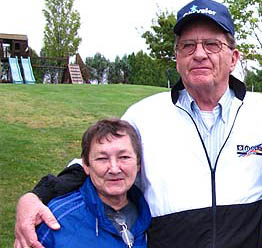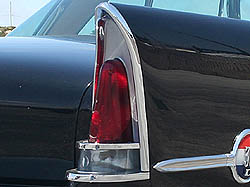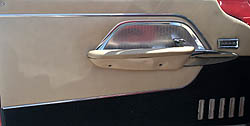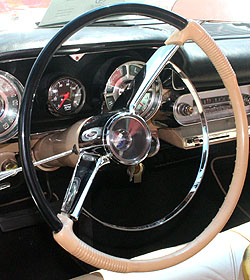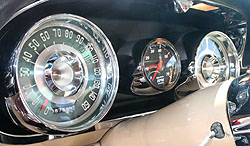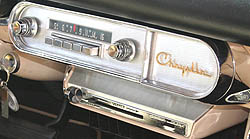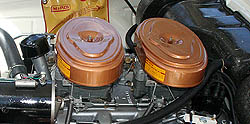Your 300C is a year old now and you are thinking
of trading it in on a new 300D. Off you go to the Chrysler Dealer.
When you see the 300D in the showroom, your first impression is that
it looks just like your 300C. But wait a minute, as you look closer
and talk with the new car salesman you find out that there are indeed
a lot of differences between the two cars.
The D is lower, taller,
wider, longer and faster(1).
It is more expensive;(2)
has a wider selection of exterior colors; more options are available;
has more of the famous red, white and blue medallions on it and the
interior uses less vinyl and more leather and chrome.
Talking with the salesman, you
discover the exterior Cloud White is Ermine White for 1958, and Jet
Black is Raven Black. But now again, as in ’56, there’s a
bright gutsy red, Matador Red for 1958. The pinkish Gaugin Red of ’57
is closely matched by Tahitian Coral. Gone is metallic Parade Green,
a color that defies description. In its place is bright swimming pool
Aztec Turquoise. In place of metallic Copper Brown is the lighter
non-metallic Mesa Tan. So as you can see, you have one more standard
color from which to choose.
While you are kicking the same 9.00 x
14 Goodyear 2 ½” WW Blue Streak tires, you suddenly
notice the windshield is different. Gone is the non-aerodynamic
spoiler. The “bubble” compound windshield (shaded and
tinted) previously used only on the C convertible is now on the
hardtop and convertible D.
In all, Chrysler decorated the D with
10 red, white, and blue medallions: 1 grille, 1 trunk, 2 side, 1
glove box, 1 steering wheel, 4 wheel covers. Chrysler managed to put
its name in only 2 places, outside on the hood and inside on the ash
receiver. “300” shows up in 13 places. These are: all 10
medallions, 2 door sill scuff plates and in large chrome numerals in
the dip of the back seat. Looking at all those ornaments, you sure
know it’s a 300. It looks like Chrysler designers couldn’t
see the forest for the trees. They got so hung up on the 300 logo
they forgot it was a Chrysler. So someone quickly hung these tiny
hood letters on it so it would say Chrysler somewhere on the outside
of the car. Maybe that’s why they look like they were an
afterthought – they were.
Opening the door of the D, you are
looking at an altogether different interior from last year.
You look for the trusty 150 MPH
speedometer and there it is along with all the rest of the gauges.
But here again, something is different. It’s the housing for
the gauges. Once painted tan, it’s been replaced by a dazzling
chrome housing for each gauge with blue tinted faces.
You have more visibility
this year than last.(1) Also,
the rear view mirror has been moved to the dash pad so it’s not
hanging from the windshield moulding.
You have more headroom in
the front seat. Both seats sit higher, giving you more leg room front
and rear(1). One
thing that hasn’t changed is the rich smell of leather that
stays with the car for years.
You can’t stand it
anymore. You have to know if the monster 392 hemi has changed, or
even if indeed it is still under the hood. Yes! It’s there and
more. Five additional horsepower has been added. Hot Damn! Whooey!
It’s 380 horses worth. Compression is increased to 10.0 to 1.
Maximum torque is also up to 435 ft. lb. at 3600 RPM’s. You
now more than ever need premium gas to run it. The service manual
recommends 99.4 Motor, 105
Research, but that’s no problem. You’ve also got a new
cam to improve low end(4),
so she ought to be better out of the hole than the C.
Closing the hood, you’re
ready and raring for the big TD (test drive!). Racing has been played
down even more this year. So naturally, you’re very curious
about performance. You turn the key, push the “N” button,
bring the engine to life, and stomp it a little to give the salesman
another grey hair. You’re wheeling with constant-control
steering, a new refinement this year. Manual steering is now an
option that goes with a racing package: manual steering, manual
transmission, manual brakes, and air conditioning not available.(3)
Speaking of racing, Chrysler, in an effort to play down the racing
characteristics of the D, lists only 5 rear axle ratios available
this year: the standard 3.31 to 1, 2.93, 3.15, 3.54, and 3.73. But
they also offer a 3.90, 3.91, 4.10, 4.30 and 4.56 to 1.(1)
Just ask them. They’ll tell you. And knowing Chrysler, who
knows what else they have and aren't telling? You gotta
ask the right question of the right people.
As you’re cruising, think of
all the “goodies” you can order this year that you
couldn’t get last year – Auto-Pilot, remote control
outside mirror, 40 amp generator and a front license plate frame, not
to mention (FUEL INJECTION!) All the other “goodies” are
still there: Air conditioning, Electro Touch Tuner or Music Master
Radio, Rear Shelf Radio Speaker (hardtop), Power Antenna, Rear Window
Defroster (hardtop), Custom Conditionaire or Instant-Heat Heater,
Power Windows, 6-way Power Seat, Solex Glass, Shaded Backlight (a
tinted, shaded rear window for hardtops), Stone Shields – rear
quarter panel, Sure-Grip Differential, and Low Back Pressure Exhaust
System (2-1/2” diameter for Fuel Injection).
After shaking some kinks out,
checking second gear pull on the old pushbutton, listening to the
throb of the carbs opening, hearing the Blue Streaks squeal and
feeling the tight and sure handling of the D, all in the course of an
average run, you look over and see the cringing, shuddering blob that
was the salesman and decide to give him a break and head back to the
barn.
You get back, look at your old C and
think a minute. You know it’s true. It does take a year to work
all the kinks out of a new model body style. The D had definitely
been refined and perfected.
“I’ll take it!”
*NOTES*
Optional rear axle ratios as listed in article, pg 11.
(2) “THE POSTWAR YEARS CHRYSLER & IMPERIAL,” Richard Langworth.
(3) Presenting the Chrysler 300D for 1958. Chrysler Division, Detroit, MI.
(4) “THE MILESTONE CAR,” No. 15,
Spring 1978, “Building the Brute,” Gil Cunningham, Pg. 8.
| ||||||||||||||||||||||||||||||||||||||||||||||||||||||||||||||||||||||||||||||||||||||||||||||||||||
